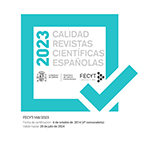El estudio del Gobierno de partidos y la autonomía de las instituciones políticas
Abstract
The two main streams in the field of the theory of the State, pluralism and marxism, have been always confronted in his explanation of the political institutions, especially about the government. The government was regarded as only an instrument in the traditional pluralism and as a reflex of the economically strongest groups in the marxist tradition. However, the last development of both approaches shows an increasingly agree around the recognition of the autonomy of the political institutions, leaving the traditional societary approaches. This recognition of an autonomy for the political field is also recently proved by the empirical works of the party Government studies, showing that we are not able to explain the governmental activity focusing on a societary dependence because of the special position where the government is placed in the political system. However, on the one hand, this evolution is almost unknown in our academic field. On the other hand, despite the coincidence on the conclusion, there is no reference between the work of the neopluralist and neomarxist approaches and the empirical work of the party Government study. This article tries to show the main arguments of this convergence analysing briefly the developments of the traditional pluralism and his evolution to the contemporary neopluralism and also for the structural neomarxism to the Bob Jessop’s postestructuralist neomarxism. At the same time we show that this approach is absolutely coherent with the empirical conclusions that the party government view has recently reached.Downloads
Article download
License
In order to support the global exchange of knowledge, the journal Política y Sociedad is allowing unrestricted access to its content as from its publication in this electronic edition, and as such it is an open-access journal. The originals published in this journal are the property of the Complutense University of Madrid and any reproduction thereof in full or in part must cite the source. All content is distributed under a Creative Commons Attribution 4.0 use and distribution licence (CC BY 4.0). This circumstance must be expressly stated in these terms where necessary. You can view the summary and the complete legal text of the licence.











